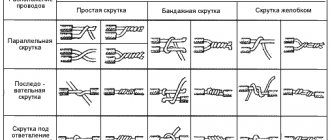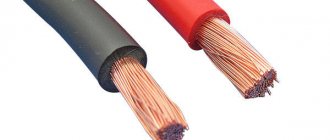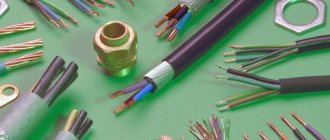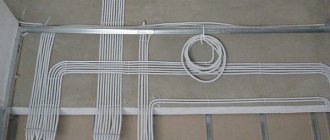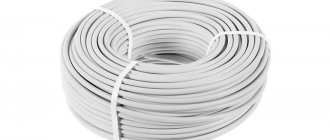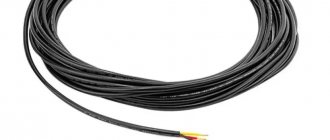Often the concepts cable and wire are used as synonyms, and only specialists knowledgeable in electricity clearly understand that these products are different. Each of them has different technical characteristics, scope of application and design. In some cases, it is possible to use only one of them. To understand the difference between a cable and a wire, it is necessary to consider both products from the point of view of their structure and purpose.
Differences
Five of them can be distinguished:
- number of conductors
- number of insulation layers
- quality of insulation and conditions of its use
- digital and letter markings
- lifetime
Let's take a closer look at how they differ and how they are similar?
Classification according to site conditions
Cables are also divided according to the conditions of use in terms of external influence of mechanical loads:
- Indoors, in trenches and channels without the influence of tensile forces. Protection is provided by winding steel tapes with an anti-corrosion coating. This is a typical KVVGng control cable, which is used in places that do not involve strong mechanical stress or the threat of fire.
- In trenches and soil without large external tensile forces. The armor layer is formed by a double steel strip with an additional outer cover of polyvinyl chloride plastic.
- In soil and channels subject to high tensile forces. The armor is formed by steel wire rods coated with a zinc layer and a cover of PVC plastic.
Designation according to GOST
First, let's decide on a name.
According to GOST 15845-80, this is what is meant by these cable products:
What is a wire? A wire is a conductor (solid or stranded) with insulation around the core in the shape of a tube. Some wires have no insulation at all.
For example, bare wires A (aluminum), AC (aluminum with a steel core), PS (steel wire), PSO (single-core steel wire).
A separate category is a relatively new type of wire - SIP (self-supporting insulated wire).
You can read in great detail about its characteristics, brands and differences in the article below.
A cable is already several insulated conductors connected into one structure. The cables have a double layer of insulation.
The insulation of the conductor itself, plus the insulation on top of all the cores. The second insulation can be from:
- place class=”aligncenter” width=”500″ height=”244″[/img]
- rubber or caoutchouc
- metal
- XLPE – cross-linked polyethylene
The most modern brands are cables made of cross-linked polyethylene.
That is, roughly speaking, it turns out that a cable is several wires combined under one protective sheath. If there is no more insulation on 2 or 3 conductors, even twisted together, then this is a wire.
Cable
This is a system of insulated conductors, which are combined into a single structure for the purpose of convenience during installation work, operation, as well as for protection from the external environment and various mechanical damage. Electrical wiring is combined together to improve safety conditions when operating electrical wires in normal and complex situations, to facilitate their joint installation. The wires are covered with an additional insulating layer.
Varieties
For a clearer understanding of what a cable is and where it is used, it is necessary to understand the existing types. Based on the scope of application, the cable is divided into the following groups: Power - designed to deliver electricity. For manufacturing, either chalk or aluminum is used.
It can withstand voltages up to 750 kV. Mounting – used to connect electrical equipment to each other. Withstands voltages up to 500 V. They are made of copper, as it is resistant to low temperatures.
- Communications - used in wired communication systems and in various alarm systems, also for laying long-distance and city communication lines.
- Controls - used in control circuits, as well as in the lighting system for machine tools and other equipment. Withstand voltage up to 600 V.
- Radio frequency – electricity is transported, as well as signals at radio frequency.
PVS or VVG
And if there is another external insulation, then can we immediately consider it a cable? No not always. This is where the mistake of many lies. A single conductor or “noodle” can be distinguished by everyone, but if there is a second shell, doubts begin.
For example, PVS, ShVVP or PUGNP are not cables at all, as some people believe, although they have external protection.
Here are the transcripts of their names:
- PVA – Wire with vinyl insulation Connecting
- SHVVP – Shnur with insulation from INinyl with a shell of INinila Psmooth
- PUGNP – Wire Universal Purpose Flexible Flat _ _ _ _
More details on the characteristics, markings and technical specifications for cables, cords and wires can be found in GOST 53768-2010.
Here is a summary comparison table of VVG cable and PVS wire. Their disadvantages and advantages.
Popular types of cables for electrical wiring
The most commonly used types of products for electrical network installations include the VVG and NYM models.
PUE 7, clause 2.1.48 states that for wiring installation, cable products should be selected in accordance with the purpose specified by the manufacturer:
- when installing low-current lines, where the load is no more than 24V, a ShVVP power cord is used;
- PVZ wire and similar products are used in cases where it is necessary to organize an additional circuit to equalize the potentials;
- To connect powerful devices, a PVS 3x6 mm2 cable is used. It is designed for laying power lines for hobs, electric stoves, refrigerators, etc.
VVG cable
The most common type of domestically produced cable. It is most often used when installing an electrical system in an apartment. Refers to unarmored flexible power cables.
Cable VVGng-LS
Consists of 1-5 metal single-wire conductors (copper), with a cross-sectional area of 1.4-240 mm2. Conductors can be round or flat and have a PVC insulating sheath and a common outer sheath.
VVG cable modifications:
- VVG – main type;
- VVGng – power cable, the outer sheath and insulation are made of non-flammable PVC;
- VVGng-LS – conductors with a self-extinguishing, non-combustible insulating sheath, which has low smoke emission;
- VVGng-FR-LS is a non-flammable cable with low smoke and has additional fire protection made of mica tape.
The VVG cable has a low cost, but its shell does not have high fire resistance, and when burned it emits a lot of smoke. This type is not suitable for bundle laying. Non-flammable products are mounted in the bundles.
We can conclude that to install electrical networks in an apartment, it is worth using reliable products of the PPGng-HF and VVGng-LS brands, since they are safer in operation:
- A cable marked VVGng-LS is the best option for installing wiring in the house. It is much safer than VVG and VVGng cables.
- If a fire occurs, the cable insulation begins to melt in any case, but the insulating sheath of the VVGng-LS cable contains less halogens than the insulation of VVGng and VVG. This halogen content will increase the time for evacuation and avoid serious damage to the respiratory system.
- The safest cable for home wiring is the PPGng-HF cable, which has a halogen-free insulating layer. It does not release caustic substances when melted.
- Cables marked VVG and VVGng cannot be used for installing a power supply system in a residential area. Despite the fact that this type of cable is non-flammable, when burned it emits a large amount of halogens, which pose a danger to human life and health.
NYM cable
Made of copper, produced at Russian enterprises under a German license. Complies with GOST and European standards and quality standards.
NYM cable
The main parameters practically coincide with the characteristics of the VVGng cable; this model is also designed for voltages up to 0.66 kW.
On sale are:
- single-wire multicore cable with a cross-section of 1.5-10 mm2;
- multi-wire cable with a cross-section of more than 16 mm2.
A rubber filler is laid between the insulating sheath made of PVC and the insulated conductors to ensure non-flammability.
Similar characteristics of NYM and VVGng cable:
Difference in insulation quality
But still, in any comparison, the quality of insulation comes first. It plays an important role depending on the installation conditions.
Many cables can be placed in aggressive environments in an open form without any cable ducts or corrugated sleeves.
But the wires, not even in an active environment, but only under the influence of water (rain), temperature changes or direct rays of sunlight, will gradually fail. Not to mention other extraneous influences.
Except of course SIP. But unlike cables, it cannot be laid underground, even in a pipe or corrugation.
Hence there will be a difference in price, although it would seem that both types are similar in design (with double insulation). Therefore, wires are used in buildings, closed switchgear (closed switchgear), and not on the street.
Sometimes, armored grades are used to lay cables in the ground and provide additional protection. In addition to all the layers of insulation, they have a layer of aluminum or lead sheath over the cores.
What is the difference between cable and wire?
The main difference between a cable and a wire is its purpose. Cables are used to transmit electric current over long distances between houses, cities, or for laying inside a building. They have additional protective layers for this. The wire is usually needed for internal installation indoors or internal installation in electrical cabinets.
Insulation
Since the cable can be laid in different, including aggressive environments, the cable insulation must be designed for this. For strength, additional armor is added - a metal braid, each core, except insulation, can be covered with an additional film, and the space between the cores is filled with an absorbent (talc) - to absorb moisture and worsen combustion.
Stranded or single-core - which is better?
Wires are:
- multi-core-flexible (one wire consists of dozens of thin wires)
For example, wire PV-3.
It is often used in the assembly of input and distribution electrical panels.
Just keep in mind that you cannot connect it without sleeves. Even in those machines with a semicircular contact pad, where it would seem that the cores should ideally occupy the entire space, everything will only get worse.
The cores will bend, become deformed, and some of them will simply not participate in the transmission of current.
Under heavy loads everything will melt and burn. This is one of the problems of connecting SIP to the machine. What lived there was not a monolith at all, and even aluminum!
- monocore-rigid (monolithic wire)
For example PV-1. If the letter “A” (APV) appears at the beginning of the name, this means the material of manufacture is aluminum. If it is not there, then the wire is copper.
Aluminum wires are not flexible. They can withstand a maximum of 10 bends, after which they break off. Copper ones can be bent up to fifty times.
Stranded are used in areas where many bends are required or where the wire must be pulled through narrow openings.
Single-core, due to their design, have less resistance. They are advantageous to install where you need to increase performance at high frequencies.
Over time, the resistance of stranded wires may increase and deteriorate.
Why is this happening?
The fact is that the surface of each thin wire is subject to oxidation. As a result, the contact between them worsens. And the cross section ceases to be uniform, changing the resistance.
A monocore will not have a similar effect. There, oxides can multiply only on the surface, but naturally will not penetrate into the solid metal.
Some electricians also consider monocore to be more resistant to short circuits. In a flexible wire, due to the fact that its copper wires are not too tightly adjacent to each other, in the first moments of a short circuit, the dynamic shock current does not immediately cover the entire cross-section of the wire, but affects more the wires near the surface.
As a result, they, being under greater load than their “internal brothers,” will melt first. But for a monocore it’s not scary - it’s solid. True, this theory is quite controversial.
Cables are also available in single-core and multi-core types. In this case, the core in this cable can be single-wire or multi-wire.
For example, if you have a KG 3*50 cable, then it would be more correct to say about it - a copper three-core cable with stranded cores. Not a three-phase cable with flexible cores. The first definition contains more information and is more accurate.
Single-core cables are called rigid, and multi-core cables are called flexible. According to flexibility, the cable is divided into six classes.
The first class is a single-core cable. Sixth grade is the cable with the best flexibility. But it also costs an order of magnitude more.
The thinner each core, the more flexible the cable. All conductors of a certain cross-section are designed for their rated current. If it exceeds this value, the insulation heats up and begins to melt.
Rigid cable is usually laid in the ground and embedded under plaster. Flexible, connects portable electrical appliances. It is also used in the manufacture of carriers and extension cords.
The advantages of a rigid cable when connecting devices is that its ends do not need to be soldered or pressed with special tips.
To connect a flexible cable, you will have to purchase a lot of different additional consumables and tools.
Often, lamps and table lamps are connected with a flexible cable. Since these devices are subject to frequent inspection, replacement of light bulbs, etc.
Which is better, mono-core or multi-core? If we approach the issue regarding operation, then there is no difference. The main difference is in the installation.
If you don’t want to buy ferrules and are willing to tinker a little longer with pulling and laying, your choice is rigid single-core.
Otherwise, choose stranded.
However, if we are not talking about a major overhaul, but, for example, extending old aluminum wiring when connecting an additional outlet, then here you need to focus only on the flexible option.
Why this is so and not otherwise, read in a separate article:
What is a wire
According to GOST, this product, consisting of wires/strands (from one to several), placed in a common non-metal sheath, is used to transmit electricity between links of the wiring chain or between the source and electrical receivers. The outer braid or winding is made of fibers of various insulating materials. The wire in accordance with GOST 15845-80 is not intended for laying under water or ground.
Classification
| Kinds | |
| For winding | |
| From copper | Made from materials with high resistance (nichrome, constantan) |
| For installation | |
| For connections | |
| Conclusion | |
| Automotive | |
| Connections | |
| For overhead lines | |
| Isolated | Without insulation |
| Others | |
Device
Structurally, the wire includes a current-carrying conductor through which electrical energy is transmitted, and insulating protection. A stranded core is several wires twisted together. Whereas a stranded wire consists of several wires isolated from each other.
The number of conductors can be from one (single-core) to several (more than 3-multi-core) conductors.
Insulation:
- Varnish coating;
- Plastic;
- Paper;
- Silk/cotton fibers.
Rated current tables
If you need to find out how much load can be passed through conductors of different cross-sections, depending on the laying conditions, voltage and material of the conductors, use the tables of rated currents for cables and wires:
CL (Cu) rubber and PVC insulationCL (Al) rubber and PVC insulationCL flexible with rubber and PVC insulationCL (Cu) with paper insulation in the groundCL (Cu) with paper insulation in the airCL (Al) with paper insulation in the groundCL (Al) with paper isolation in the air
The average service life of a double-insulated cable is 30 years. Single wires - less than 15 years.
Which cable is NOT RECOMMENDED to be used?
In addition to cables intended for installation of electrical wiring, there are cable products not intended for these purposes. Despite this, unscrupulous electricians use these types of cable products for installation of electrical wiring due to their low price and ease of use.
PVS wire
According to the manufacturers, this wire is intended for connecting mobile electrical appliances, making carriers and for other similar purposes.
This type of cable product does not have a certificate for the distribution of electricity and use as a cable for hidden electrical wiring. The service life of this product is only 10 years. This is quite enough for carrying or connecting a moving mechanism, but very little for electrical wiring hidden in a layer of plaster.
This is due to the properties of the insulation - it is designed for constant bending, therefore it is softer and less durable than that of VVG and NYM cables. Naturally, a plastered cable left undisturbed will last longer than 10 years, but no one can say how long.
However, this cable is widely used for laying electrical wiring by non-professionals, as well as hacks and factory electricians who have a vague understanding of GOST standards and certificates. This is due to its flexibility, ease of use and low price.
Important! This wire cannot be connected to modern sockets and switches without using NShVI lugs. In these devices, the wire is pressed with a bolt, which “flattens” the wire and breaks the wires, so the use of lugs is mandatory.
ShVVP wire
The SHVVP wire (more precisely, not a wire, but a cord) is even less suitable for electrical wiring than PVS. With similar insulation of current-carrying conductors, the overall shell is much thinner. This cable is designed for connecting lamps and is made of very low quality by almost all manufacturers. Very often this wire is incorrectly marked, exaggerating the actual cross-section - 2.5mm² instead of 1.5mm² or 1.5mm² instead of 0.75mm². Using such a wire may result in overheating, short circuit and even fire.
The declared service life is similar to PVA wire, but thinner insulation reduces the actual service life.
Wire PUNP
The use of this wire is strictly prohibited. Due to its poor quality, there have been many cases of electrical wiring and fires in Russia. Currently, technical specifications TU 16.K13-020-93 have been canceled and the production of this wire has been discontinued.
Unlike GOST 22483-77, the technical conditions according to which the wire was produced made it possible to underestimate the cross-section of the current-carrying core by 30%. This means that when purchasing a cable with a cross-section of 2.5 mm², its actual cross-section may turn out to be 1.75 mm². Naturally, such a conductor will overheat during operation.
In addition, according to TU 16.K13-020-93, the product was produced with insulation of only 0.3 mm, in contrast to GOST 23286-78, which provides for this parameter to be at least 0.4-0-5 mm.
These factors make it dangerous to use PUNP for electrical wiring. The only safe use of this wire is connecting sockets in chandeliers, sconces and other indoor lamps.
Information! In connection with the ban on the production of PUNP cable, some manufacturers began producing it under new names - PUNPbm, PUGNP, PBPP and others, which does not make its use safer.
Conclusion
And yet, what cable should I use for wiring in the apartment? To summarize the article, we can say that the best choice for a single-core cable is VVGng-ls or NYMng-ls from the original manufacturer, and for a multi-core cable - KGVVng-ls.
If these types of cable products are not commercially available or their installation is impossible for financial reasons, then it is allowed to use VVGng and NYM from a domestic manufacturer, but the ends of the latter should be sealed with heat-shrinkable tubing.
| The use of PVS cable is not recommended, and PUNP, its clones and ShVVP are strictly prohibited. |
Similar materials on the site:
- Description and characteristics of NYM cable
- Which cable is better VVGng or NYM
- 5 ways to secure a cable to the wall
How to use it correctly
Suitable for installation in power plant, industrial plant, lighting, channel, tunnel and other sites. Due to the fact that it is resistant to combustion, it is widely used where there is a high probability of explosions with fire. Safe to use thanks to armor. It is worth pointing out that due to the gasket, it is recommended to provide protection using a cable duct, corrugation, metal sleeve and other things.
As for the moment of use, the place, period and conditions of safety of the conductor must be thought out. In an open area, the shelf life is several years, under a canopy - 5 years, and in a warehouse - 10 years.
It should be noted that the lower part must be brought out and secured with sheet metal. The top should be secured to the inside of the drum. Each end should be equipped with heat-shrinkable, moisture-proof mouth guards. If there is a metal shell, then its ends must be sealed or wrapped with PVC tape. Otherwise, plastic with rubber insulation will be fragile and may lose its own qualities.
Note! It is important to understand that laying outdoors is dangerous due to wind, frost and ultraviolet radiation. In this case, the cable should be protected from rupture as much as possible and secured to a steel cable. To prevent it from cracking, you should use corrugation
To prevent it from cracking, you should use corrugation
An excellent option would be to use a metal hose or polyamide corrugated pipe
To prevent it from cracking, you should use corrugation. An excellent option would be to use a metal hose or polyamide corrugated pipe.
In general, the VVG cable is a conductor with a wide range of standard sizes, ease of installation and low cost. It is divided into 8 main varieties, each of which has its own design, functional mechanical and electrical parameters. It is used in all spheres of human activity according to special instructions.

